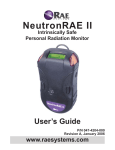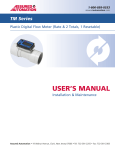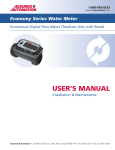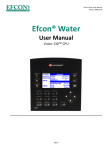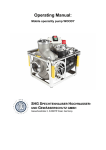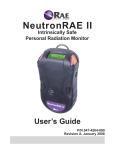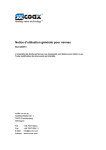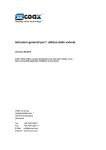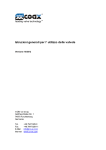Download USER`S MANUAL - Assured Automation
Transcript
1-800-899-0553 assuredautomation.com VAX Series High Pressure 2-way/3-way Coaxial Valve USER’S MANUAL Installation & Maintenance Assured Automation • 19 Walnut Avenue, Clark, New Jersey 07066 • Tel: 732-381-2255 • Fax: 732-381-2383 1-800-899-0553 assuredautomation.com 1. GENERAL 1.2.2 The Datasheets In order to ensure successful and safe operation of the VAX valves, the entire User’s Manual must be read and understood prior to installation and commissioning. Special attention must be placed on the safety instructions. These contain supplementary additional information and technical data necessary for the individual specific VAX valve types. Use the datasheets only in connection with the User’s Manual. In particular, observe the safety instructions in the User’s Manual! Warning: Before using our VAX valves, read and observe the safety regulations. Should difficulties arise that cannot be solved with the help of the User’s Manual, please contact the supplier or manufacturer. This User’s Manual covers the areas of installation/commissioning, maintenance, repair, storage, packaging, transport and disposal. The operator is responsible for adhering to local safety regulations also with regard to the assembly personnel employed. When using the VAX valves, the operator or those responsible for the design of the plant must ensure that valid national regulations are adhered to. The manufacturer reserves all rights to make technical changes and improvements at any time. The use of this User’s Manual and the direct handling of VAX valves requires that the user be qualified as described in section 1.1. 1.3 Safekeeping Access to the entire User’s Manual must be guaranteed at all times at the place of operation of VAX valves. 2. PRODUCT DESCRIPTION 2.1 Important Information Concerning VAX Valves 2.1.1 Purpose The type of medium (chemical, abrasive and corrosive effect) must agree with the order. The limit values of medium pressure and temperature set forth in the datasheet must be adhered to. Any other or additional use is not in accordance with that intended. The area of operation of the VAX valves is the responsibility of the plant planner. Observe special VAX valve markings. 1.1 Target Group 2.1.2 Precautionary Measures The User’s Manual is directed at persons who are entrusted with the installation planning, installation, commissioning or maintenance/repair and have qualifications in accordance with their activities and functions and who, based on their technical training, their knowledge and experience and their knowledge of the applicable standards, are able to evaluate the work assigned to them and recognize possible hazards. When using VAX valves, observe the currently applicable laws (e.g. national regulations) and the recognized rules of engineering, i.e. DIN standards, DVGW information and working sheets, VDI guidelines, VDMA standard sheets, etc. This also includes the knowledge of applicable accident prevention regulations, generally recognized safety regulations, and countryspecific standards and regulations. 1.1.1 Personnel Qualification Transport, installation, commissioning, maintenance or repair must only be performed by trained or instructed personnel. Electrical installation: Work on electrical equipment of the device must only be performed by a qualified electrician or instructed persons under the guidance and supervision of a qualified electrician according to the rules of engineering. 1.2 Documentary Structure The standard User’s Manual for our VAX valves consist of two main modules: 1.2.1 The User’s Manual This contains important basic information and safety instructions for the safe handling of all VAX valves. On systems subject to supervision, adhere to the applicable laws and regulations, e.g. code of commerce, accident prevention regulations, boiler regulations, regulations concerning high gas pressure lines, regulations concerning combustible liquids and the technical regulatory works VDE, TAB, TRD, TRG, TRbF, TRGL, TRAC, AD information sheets, etc. The general equipment and safety regulations for pipeline and plant construction and the local safety and accident prevention regulations apply in addition. It is imperative to comply with the User’s Manual with regard to all work on VAX valves and whenever handling VAX valves. Warning: Failure to observe the Operating Manual can result in serious injuries or damage to property (e.g. due to mechanical, chemical or electrical effects). 2.1.3 Conformity The VAX valves have been built according to the state of the art and in accordance with the guideline 97/23/EC concerning pressure devices. 2.2 Technical Data The housing materials and sealing materials are selected in accordance with the operating conditions specified by the Contact us for the most recent product and technical information. Visit our website for more details: assuredautomation.com 2 1-800-899-0553 assuredautomation.com customer with the order. These operating conditions have a major effect on the service life of the VAX valves for instance due to abrasion, chemical or corrosive attack of the materials. The VAX valves have been designed without wear allowance and statically with 1.5 times the safety of the rated pressure at room temperature. appropriate safety and protective working equipment as well as training in first aid, etc. The technical data (also electrical) and the essential permissible limit values, especially of medium pressure and temperature, is included in the datasheet. 3.2.2 Transport / Installation / Commissioning / Maintenance / Repair 3. SAFETY INSTRUCTIONS This chapter contains important general safety instructions. However, the special safety instructions in the remaining sections must also be observed. Observing other notes and information not specially emphasized is equally indispensable in order to avoid disruptions, which in turn could result in direct or indirect damage to persons or property. 3.1 Product Safety The VAX valves comply with the state of the art and the recognized rules of technical safety, but dangers can still arise. Operate the VAX valves only in perfect condition taking into account the entire User’s Manual. The VAX valves are only intended for the purpose according to section 2.1.1. Warning: Use of material-incompatible media, exceeding the limit values of medium pressure and temperature and mechanical additional loads such as caused by connected pipelines can result in failure of the VAX valve material and bursting of the VAX valve. They must have read and understood the entire User’s Manual. No changes, attachments or conversions must be performed without approval of the manufacturer or supplier. Only by trained or instructed personnel. For safety reasons, recheck whether all necessary measures for the protection of persons have been taken before commencing the work. VAX valves that have come in contact with harmful media must be decontaminated prior to the work. 3.2.3 Electrical Installation Electrical energy hazards must be excluded. Work on electrical equipment of the device must only be performed by an electrician or persons under the guidance and supervision of an electrician in accordance with the rules of engineering. 3.3 Product-specific Dangers Hazards that may arise from the flow medium, the control pressure and moving parts must be prevented through suitable measures. In addition to this, ensure that the VAX valves are employed only where the type of medium, operating pressure and temperatures correspond with the design criteria used as a base for the order and specified on the nameplate. Proper transport and proper storage of the VAX valves are assumed as a matter of course. The following sections contain a number of product-specific dangers and measures for their avoidance: 3.3.1 Use of a Medium Unsuitable for the VAX Valves 3.2 Organizational, Personnel Information 3.2.1 General Observe the recognized rules of industrial safety. The persons entrusted with the installation planning, installation, commissioning, maintenance or repair must be qualified in accordance with their activities and functions. Based on their technical training, their knowledge and experience and their knowledge of the applicable standards, the personnel must be able to evaluate the work entrusted to them, understand the interactions between VAX valves and system and recognize possible dangers. They must also have knowledge of applicable accident prevention regulations, generally recognized safety regulations, and countryspecific standards and regulations and all application-based regional and company-internal regulations and requirements. They must have passed training or instructions in accordance with the standards of safety engineering in the care and use of The VAX valve materials are compatible only with certain media. Please contact the manufacturer or supplier when used for media requiring or excluding certain materials. Danger: When using unintended media, the materials included in the VAX valve may be attacked or could even combust with fatal consequences. For this reason, only use media for which the VAX valve has been approved. Keep VAX valves for oxygen free of oil and grease. For ammonia, use VAX valves free of non-ferrous metals. For combustible, aggressive or toxic media, use VAX valves made of suitable materials. 3.3.2 Reduction of Required Minimum Wall Thickness Through Corrosion or Abrasion Warning: Regularly carry out inspections to determine the technically safe condition of the inner wall. Contact us for the most recent product and technical information. Visit our website for more details: assuredautomation.com 3 1-800-899-0553 assuredautomation.com 3.3.3 Exceeding the Permissible Pressure with Risk of Bursting A cause for such exceeding could be, for instance, so-called closing hammer or cavitation. Closing hammer are pressure peaks, which occur when a pipe is closed by means of a VAX valve. The reason for this, expressed in simple terms, is the momentum of the moved medium column impacting on the closing VAX valve. Warning: The pressure peaks occurring during closing can reach a multiple of the pressure at rest. The user must select the operating pressure stage of the VAX valve so that the pressure peaks occurring in the concrete installation situation do not exceed the maximum permissible operating pressure of the VAX valve. With the flow, the static pressure of a liquid media must additionally always be above the vapor pressure of the medium in order to avoid cavitation. 3.3.4 VAX Valve Overload VAX valve overloads can be triggered through additional loads such as, for instance, stepping loads, connected pipelines or high ambient temperature. Warning: The VAX valve is only intended for the permissible medium pressure load. For this reason, install the VAX valve without force and ensure that no additional loads occur due to pipelines or stepping loads. No welding operations or heat treatments must be performed or mounting holes be provided on the walls subject to pressure. Install the VAX valve and the electrical and pneumatic lines so that they cannot be damaged and no moisture-induced short circuit can occur on electrical plug connections. 3.3.5 Opening Screw Connections with Pressurized VAX Valve Opening screw connections with pressurized VAX valve results in the leakage of medium and damages the VAX valve. 3.3.6 Leakage of Dangerous Substances Dangerous substances can leak for instance from relief bores or when disassembling the VAX valve. Warning: Collect and dispose of dangerous media (for instance leakages from relief bores or traces of medium remaining during the disassembly of the VAX valve) so that persons and the environment are not endangered. Observe all applicable legal requirements. 3.3.7 Free VAX Valve Outlet If nothing is connected to the outlet of a VAX valve, the exiting medium could constitute a hazard during the (possibly inadvertent) opening of the VAX valve. Warning: In order to avoid any hazardous conditions on the discharge side of the VAX valve, the exiting media should go into an appropriate fixture. 3.3.8 Drive Energy Failure Upon failure of the actuator, the VAX valve could change to a condition that is unsafe for the intended operation. Caution: Deliberately select the VAX valve function (NC/NO) so that the VAX valve assumes the operating condition that is safe for the intended operation in the event of drive energy failure. 3.3.9 Paintwork When carrying out painting operations the VAX valve could be accidentally painted. This would impair the heat radiation of the magnet or clog the relief bore. Note: Effectively cover the VAX valves when carrying out work such as concrete, plastering, painting or sandblasting operations in the area of the VAX valve, which could adversely affect it. 3.5 Emergency Information Danger: Opening pressurized VAX valves can be fatal! Warning: Prior to any work on the VAX valve depressurize the VAX valve and all connected lines. Ensure that the VAX valve is electrically de-energized. Allow VAX valve and medium to cool down. The temperature must be below the evaporation temperature of the medium in order to prevent scalding. With media that is caustic, combustible, aggressive or toxic, flush the pipe system and ventilate, wear goggles or protective mask with eye protection or take other necessary protective measures. In the event of fires, use only such extinguishing agents as are suitable for the extinguishing of corresponding electrical systems. Ensure that the extinguishing agent does not result in a dangerous reaction together with a possibly leaking medium. 4. INSTALLATION / COMMISIONING Warning: Read and observe the general safety instructions in section 3 prior to installation or commissioning. Whenever handling the VAX valves, always observe the applicable accident prevention regulations. Contact us for the most recent product and technical information. Visit our website for more details: assuredautomation.com 4 1-800-899-0553 assuredautomation.com 4.1 Measures and Considerations Prior to Installation Always observe the following when installing: Compare material, pressure and temperature details of the VAX valves with the operating conditions of the pipeline system to verify material resistance and load capacity. Possible water hammer must not exceed the maximum permissible pressure of the VAX valve. Warning: Water hammer can reach a multiple of the pressure at rest. With the flow, the static pressure of a liquid medium must always be above the vapor pressure of the medium in order to avoid cavitation. Install the VAX valve so that it is well accessible (e.g. connections on drive, sensors and control devices, etc.) for all connection and maintenance operations that might become necessary later on. Otherwise the installation position can be any appropriate position. Install a suitable dirt trap in front of the VAX valve in order to ensure trouble-free VAX valve operation. It is advisable to install hand shut-off valves in front of the dirt trap and behind the VAX valve so that maintenance operations can be performed on the dirt trap and the VAX valve without having to drain the entire system. If the system is to operate without any interruption, a bypass line should be included when planning the system. Protect the VAX valve from the direct effects of the weather when installing in the open. Install the VAX valve so that no mechanical loads such as pipe stress are exerted on the VAX valve during and after the installation. The VAX valve must always be loaded only with the intended medium internal pressure, without additional mechanical loads. Warning: Additional mechanical loads can result in malfunctioning or overloading and bursting especially of a VAX valve under medium pressure. For force free installation, the connection lines must be axially aligned with the VAX valve connections and have the correct distance. Heat expansion of the pipelines must be offset by compensators. The transfer of vibrations must be avoided through flexible vibration compensators if required. 4.2 VAX Valve Installation Warning: Before installing the VAX valve, inspect for possible transport damage. Damaged VAX valves may no longer comply with the safety requirements and must not be installed. Note: Before installing the VAX valve, check the pipe system for absolute cleanliness in order to prevent traces from the pipe installation or other foreign bodies from being flushed into the VAX valve during commissioning. When installing the VAX valve on non-conductive pipes, it must be grounded. Remove protective caps on the connections only immediately prior to the installation without damaging existing sealing surfaces or threads. The sealing surfaces must be in good technical condition. Piping must be flushed clean of scale, tape and other debris. Each valve is built for specific media and certain applications as indicated by the seal material as shown on the data plate. The operating pressure must not exceed that shown on the data plate. Use only permissible fasteners (e.g. according to DIN EN 1515-1) and permissible sealing elements (e.g. according to DIN EN 1514). VAX valves and pipelines operated at high (> 50º C) or low temperatures (< 0º C) must be protected against touching through insulation or the danger of possible contact must be pointed out through appropriate warning signs. In the event of condensate formation or the risk of icing-up in air conditioning, cooling and refrigeration systems, the complete VAX valve must be furnished with a suitable diffusion-proof insulation. Icing-up may cause the drive to be blocked. 4.2.1 Installation with Thread Connection Adhere to the flow direction specified on the VAX valve to ensure that the VAX valve is able to operate as intended. Use suitable sealing material. Install the piping so that the flow of force is not by way of the longitudinal axis of the VAX valve. The valves must be installed so that no longitudinal, twisting, compression or shearing forces are applied. When threading pipe into the valve, care should be taken to hold the port the pipe is being threaded into while tightening the pipe, so as not to twist the valve. It is also important to hold the appropriate port while adjusting the tie-screws, so as not to twist the valve. Following installation, perform leak and operating tests. 4.3 Electrical Connection Work on electrical equipment of the VAX valve must only be performed by a qualified electrician or by instructed persons under the guidance and supervision of a qualified electrician according to the rules of engineering taking into account DIN EN 60204-1 (electrical equipment of machines), the VDE regulations including the safety regulations, the accident prevention regulations and the User’s Manual. The electrical connection is made via the plug DIN 43650 (see Fig. 1). Be sure the supply voltage matches that listed on the plate. The valves are polarity neutral. The coils are always and only operated by DC current; valves specified for AC current include a connector with integral rectifier. Contact us for the most recent product and technical information. Visit our website for more details: assuredautomation.com Fig. 1 5 1-800-899-0553 assuredautomation.com Connect after unscrewing the respective plug connection. Prior to any electrical work on the VAX valve, de-energize all poles and secure appropriately. Connect the VAX valve to ground according to local regulations. No protective measures are specified in the wiring diagrams. These must be additionally provided when connecting the VAX valve according to VDE 0100 and the regulations of the respective responsible electrical supply companies. Whenever installing anything electrical always ensure that only the specified voltage in the correct polarity is connected in order to avoid damage or hazards. If the VAX valve is equipped with additional equipment such as limit switch, etc., always observe the appropriate datasheets and wiring information. The electrical characteristics and a wiring diagram are included in the datasheet. 4.4 Pneumatic Connection Use conditioned air for pneumatically activated VAX valves. A filter-regulator must be installed ahead of the air actuation ports or pilot valve air inlet port. When installing externally controlled valves, the actuator/pilot valve port designations must be noted. Actuator ports “2” and “4” are 1/8 NPT (see Fig. 2). Actuating port 2: non energized position Actuating port 4: energizes the valve The actuation pressure range must be within 4-8 bar (60-120 PSI). Fig. 2 Normally Open Normally Open Prior to every commissioning of a new system or re-commissioning of a system after repairs or conversions, ensure the following: TRB 700 is observed. All installation and assembly work has been properly completed. Commissioning only by qualified personnel according to section 3.3. The pipe system has been thoroughly flushed with fully opened VAX valves to remove contamination harmful to the sealing surfaces. The VAX valve is in the correct operating position. Existing protection and guards have been reinstalled or enabled. 5. MAINTENANCE Warning: Prior to any work on the VAX valve, read and observe the general safety instructions in section 3.0. Danger: The opening of VAX valves under pressure can be fatal! Our VAX valves are largely maintenance-free. For operating safety reasons, however, all VAX valves should nevertheless be checked at regular intervals, e.g. external condition, including accessories. In general, VAX valves should be operated regularly so as not to impair operation of all moving parts through long periods of disuse. Maintenance and maintenance intervals must be determined by the operator in accordance with the operating conditions (refer also to TRB 700). Caution: The VAX valve and connected pipelines can be very cold or very hot due to the temperature of the medium. VAX valves with magnetic drive can also have high temperatures due to the electrical dissipation of the drive. 6. REPAIR 4 2 2 4 Normally Closed 4 2 2 4 Normally Closed 4.5 Commissioning Warning: Prior to any work on the VAX valve, read and observe the general safety instructions in section 3.0. VAX valves, which come in contact with health threatening media at the customer, must be decontaminated prior to any repair. Danger: Disassembling VAX valves under pressure can be fatal! Caution: The VAX valve and connected pipelines can be very cold or very hot due to the temperature of the medium. VAX valves with magnetic drive can also have high temperatures due to the heat dissipation of the solenoid. Warning: Prior to commissioning, read and observe the safety instructions in section 3.0. Contact us for the most recent product and technical information. Visit our website for more details: assuredautomation.com 6 1-800-899-0553 assuredautomation.com Warning: Before carrying out any work on the VAX valve, ensure the following: The VAX valve and all connected pipes must be depressurized. Allow system and medium to cool down. The temperature must also be below the evaporation temperature of the medium in order to prevent scalding. Ensure that the VAX valve is de-energized and inadvertent movements of the drive are excluded. Please consider that the VAX valve spring is loaded (serious injuries are possible). With media that are caustic, combustible, aggressive or toxic, flush and ventilate the pipeline system, wear goggles or protective mask with eye protection and take other necessary protective measures. Traces of medium remaining in the VAX valve during the disassembly must be collected and disposed so that persons and the environment are not endangered. Adhere to all applicable legal requirements. VAX valves that have come in contact with health-threatening media must be decontaminated prior to the work. The VAX valve must be returned to the manufacturer for repair work. After consultation and approval by the manufacturer, such work can be performed on-site in exceptional cases by qualified and specially trained personnel. On no account may the VAX valves be removed without prior approval by the manufacturer. When disassembling the VAX valve, observe the generally applicable installation guidelines and the TRB 700. Assembly and disassembly operation shall only be conducted by qualified personnel (see section 3.3) according to the manufacturer’s instructions. Use new replacement parts after every parts removal/conversion. Use only original VAX replacement parts from the manufacturer. Caution: Prior to re-commissioning, read and observe section 4.5 concerning Commissioning. Subject the VAX valves to a strength and leak test according to DIN 3230 after each repair and prior to commissioning. 8. PACKAGING Warning: VAX valves that have come in contact with healththreatening media at the customer must be decontaminated prior to packaging. Pack the VAX valves so that any coatings or accessories such as plug-in devices and sensors cannot be damaged through subsequent transport. Protect connection openings to prevent the entry of dirt. Use the packing material in accordance with the applicable regulations and observe country-specific regulations. 9. TRANSPORT Warning: VAX valves that have come in contact with healththreatening media must be decontaminated prior to the transport. Whenever handling the VAX valves, always observe the valid accident prevention regulations. Transport temperature -20º C to +65º C. Protect against external force (shock, impact, vibration, etc.). Protect existing sealing surfaces on the connections from damage. Do not damage the corrosion protection layer. 10. DISPOSAL Warning: VAX valves that have come in contact with healththreatening media must be decontaminated prior to disposal. Observe all applicable legal requirements for appropriate disposal in order to protect the environment. 11. REPLACEMENT PARTS If replacement parts are required, please contact the distributor or manufacturer. 7. STORAGE During storage, protect the VAX valves from external effects and dirt. Avoid the formation of condensate through ventilation, desiccant or heating. Protect the connection openings to prevent entry of dirt. Store the VAX valves so that their functionality is maintained even after prolonged storage. To this end, the guidelines for the storage of elastomers (DIN 7716) must also be observed in particular: The storage room should be dry, dust-free and moderately ventilated. Storage temperature frostfree up to +25º C. Existing stocks should be used up first in order to achieve the shortest possible storage times. Store replacement parts so that elastomers are not exposed to sunlight or UV light from other sources. Contact us for the most recent product and technical information. Visit our website for more details: assuredautomation.com 7








